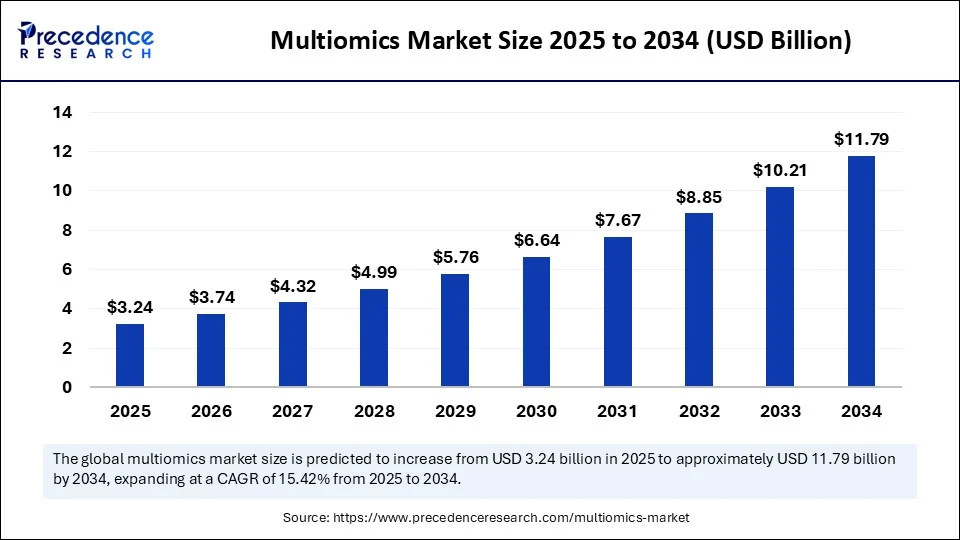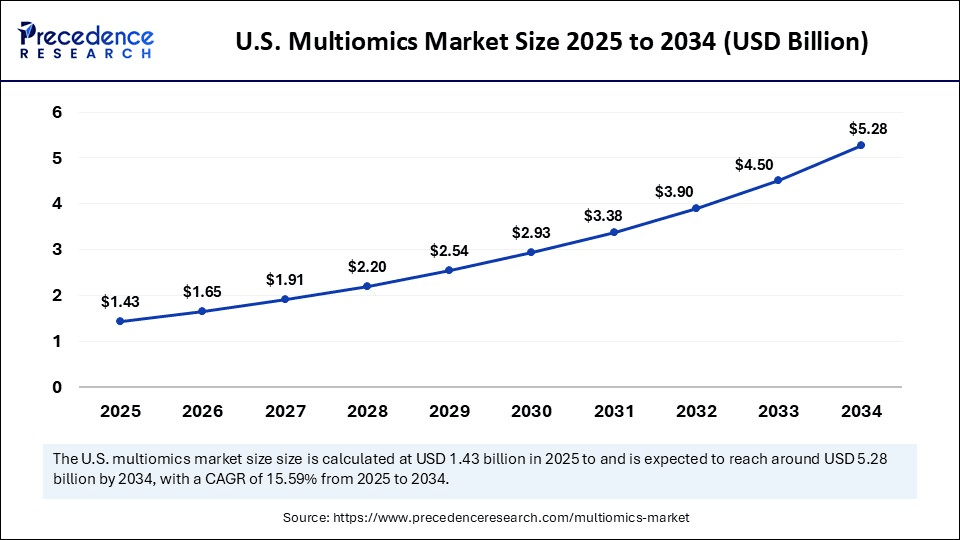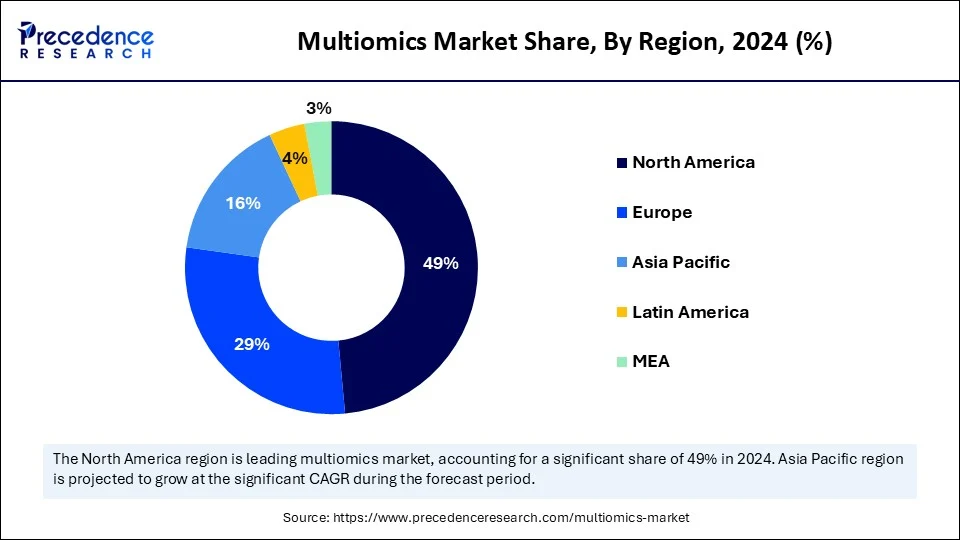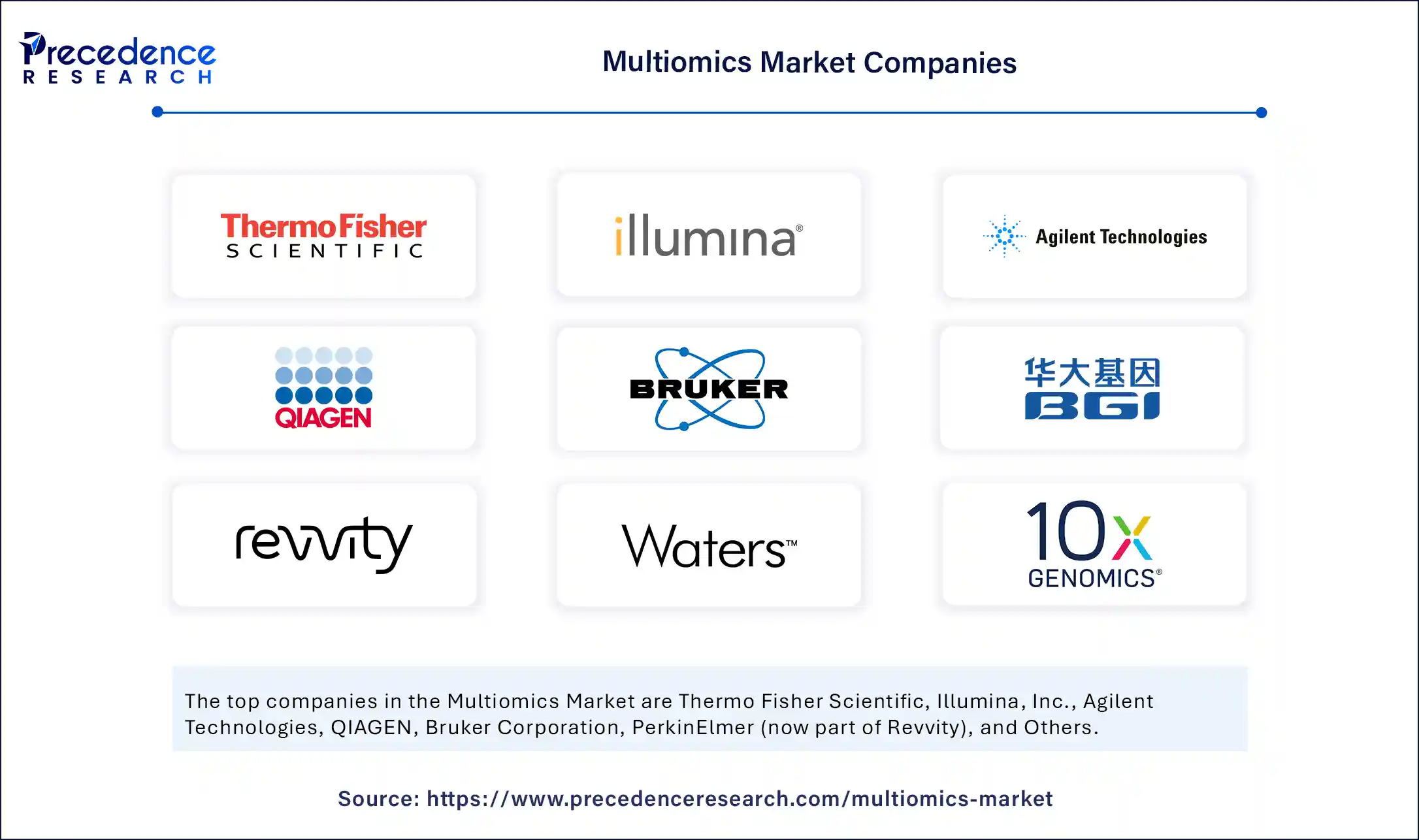List of Contents
Multiomics Market Size and Forecast 2025 to 2034
The global multiomics market size accounted for USD 2.81 billion in 2024 and is predicted to increase from USD 3.24 billion in 2025 to approximately USD 11.79 billion by 2034, expanding at a CAGR of 15.42% from 2025 to 2034.The market is experiencing rapid growth due to the increasing prevalence of chronic diseases, which is creating the need for early and accurate diagnostics. The growth of the market is further driven by a heightened focus on personalized medicine and advancements in high-throughput technologies. Additionally, the rising demand for integrated approaches to understand disease mechanisms is contributing to market expansion.

Multiomics Market Key Takeaways
- In terms of revenue, the global multiomics market was valued at USD 2.81 billion in 2024.
- It is projected to reach USD 11.79 billion by 2034.
- The market is expected to grow at a CAGR of 15.42% from 2025 to 2034
- North America accounted for the largest revenue share of 49% in 2024.
- Asia Pacific is expected to grow at a significant CAGR of 18% from 2025 to 2034.
- By omics type, the genomics segment held a 42% share of the market in 2024.
- By omics type, the metabolomics segment is expected to grow at the fastest CAGR over the projected period.
- By application, the drug discovery & development segment captured the largest market share of 39% in 2024.
- By application, the precision medicine and personalized therapy segment is anticipated to grow at a significant CAGR from 2025 to 2034.
- By technology, the mass spectrometry (MS) segment held the biggest market share of 34% in 2024.
- By technology, the multiomics integration platforms (AI/ML-based) segment is projected to expand at a significant CAGR from 2025 to 2034.
- By offering, the software and services segment held the major market share of 51% in 2024.
- By offering, the instruments segment is projected to grow at the highest CAGR between 2025 and 2034.
- By end-user, the pharmaceutical and biotechnology companies segment led the market share of 46% in 2024.
- By end-user, the hospitals and clinics segment is expected to grow at a significant CAGR over the projected period.
How is AI Transforming the Multiomics Market?
Artificial intelligenceis transforming the multiomics market by enabling faster and more efficient analysis of large datasets from various omics fields, leading to breakthroughs in understanding diseases, drug discovery, and personalized medicine. AI algorithms can integrate and analyze data from genomics, proteomics, metabolomics, and other sources to identify disease subtypes, drug targets, and biomarkers. AI also accelerates drug discovery by identifying potential drug targets, predicting efficacy, and optimizing drug design, contributing to improved diagnoses and prognoses. It can develop predictive models to identify individuals at risk for certain diseases or predict their treatment responses.
- In October 2024, at the ESGCT Congress, Whitelab Genomics shared key insights on how AI can transform genomic medicine. Their platform uses extensive datasets to create in-silico simulations that streamline the design and optimization of AAV vectors, drastically reducing development timelines while improving targeting specificity, aiming to unlock the full potential of genomic medicine.
(Source: https://whitelabgx.com)
U.S. Multiomics Market Size and Growth 2025 to 2034
The U.S. multiomics market size was exhibited at USD 1.24 billion in 2024 and is projected to be worth around USD 5.28 billion by 2034, growing at a CAGR of 15.59% from 2025 to 2034.

What Made North America the Dominant Region in the Multiomics Market in 2024?
North America dominated the global market with a 49% share in 2024. This is primarily due to its robust research infrastructure and substantial investments in healthcare and biotech R&D, which are supported by both government and private sector funding. The region benefits from the presence of major life science companies, including Thermo Fisher Scientific, Illumina, Agilent Technologies, and QIAGEN, which leads to innovations in the multiomics approach. North America also boasts world-class research institutions, including Harvard, MIT, and the NIH, which lead to increased research activities. Government programs, NIH's multiomics investments, and the FDA's support for biomarker-guided drug development provide essential financial and regulatory backing.
U.S. Multiomics Market Trends
The U.S. is leading the charge. The market within the U.S. is driven by strong research infrastructure, significant government funding, and the presence of prominent biotechnology and pharmaceutical companies. The country is at the forefront of developing and applying advanced technologies like next-generation sequencing, mass spectrometry, and bioinformatics tools for multiomics analysis. Additionally, the U.S. market is marked by intense competition, active research and development efforts, and a focus on personalized medicine, further boosting the multiomics sector.

What Factors Support Asia Pacific's Growth in the Multiomics Market?
Asia Pacific is expected to grow at the fastest CAGR of 18% from 2025 to 2034, owing to increasing investments in life sciences research, a rising number of biotech startups, and expanding healthcare infrastructure, especially in countries like China, Japan, and India. Governments across the region actively encourage biotech growth through various initiatives and policies, such as India's National Development Programmes (NDPs) and Sustainable Development Goals (SDGs), which support biotech development and promote biomanufacturing. With the growing prevalence of various diseases, there is a strong focus on novel drug discovery, contributing to regional market growth.
China Multiomics Market Trends
China is a major player in the market within Asia Pacific. This is mainly due to its substantial investments in genomics research, precision medicine initiatives, and biotech development. China is emerging as a leader in multiomics. There is a widespread application of multiomics in areas such as disease diagnosis and treatment. Companies like BGI Group are key players in China's multiomics landscape.
India Multiomics Market Trends
India also plays a significant role in the market, fueled by increasing emphasis on personalized medicine, advances in high-throughput technologies, and government investments in life science R&D. The multiomics approach is vital for understanding complex diseases and developing targeted therapies. India's contribution is especially notable in cancer research, with initiatives like the Indian Cancer Genome Atlas (ICGA) creating valuable datasets for personalized treatment.
Why Does Europe Consider a Significant Region in the Multiomics Market?
Europe is considered to be a significantly growing area. This is primarily due to its greater emphasis on genomics research, substantial government funding, and the increasing adoption of personalized healthcare. European governments support multiomics through initiatives like the France Genomic Medicine Plan 2025 and research programs such as Horizon Europe. Projects like the 1+ Million Genomes and collaborations like EATRIS-Plus demonstrate Europe's commitment to advancing multiomics research and integrating it into healthcare.
How Will Latin America Make an Impact on the Multiomics Market?
Latin America is experiencing steady growth in the market, driven by its diverse population, increasing focus on personalized medicine, and expanding healthcare infrastructure. While not specific to multiomics, broader advancements in technology and healthcare, along with government support for innovation, create a fertile environment for the adoption of multiomics. Brazil actively promotes biotech research, including investments in genomics and related fields, which support multiomics applications. Favorable trade agreements and rising foreign investment further boost the region's economic growth, making it more attractive for multiomics companies.
What Opportunities Exist in the Middle East and Africa Multiomics Market?
The Middle East and Africa are also witnessing notable growth in the multiomics sector, driven by increased investments in healthcare infrastructure, heightened awareness of precision medicine, and collaborations between local and global entities. Several government initiatives and partnerships focus on healthcare advancement and biotech development. The UAE emphasizes healthcare improvements, boosting the adoption of multiomics technologies. Companies such as BD, Thermo Fisher Scientific, Illumina, and QIAGEN are expanding their presence in the region, thereby supporting market growth.
Market Overview
The multiomics market encompasses the integrated analysis of data across multiple omics domains, including genomics, proteomics, transcriptomics, metabolomics, and epigenomics, to gain a comprehensive, system-level understanding of biological processes. This approach is driving significant growth due to its potential to revolutionize personalized medicine, biomarker discovery, drug development, and clinical diagnostics by combining diverse molecular data types to uncover disease mechanisms, patient responses, and therapeutic targets. The rising prevalence of various life-threatening diseases, high demand for precision medicine, and advances in next-generation sequencing technologies are boosting the growth of this market.
What Are the Key Trends in the Multiomics Market?
- Increasing Prevalence of Chronic Diseases: The rising prevalence of chronic diseases, including cancer, diabetes, and cardiovascular diseases, is driving the demand for multiomics approaches to understand disease mechanisms and identify new therapeutic targets, leading to more effective diagnostic and therapeutic strategies.
- Growing Demand for Single-Cell Multiomics: The emergence of single-cell multiomics is enabling researchers to study cellular heterogeneity and dynamics at an unprecedented level, gaining traction, and leading to discoveries in disease and treatment response, thereby further expanding the market.
- Increased Research and Development Investments: Investments in multiomics research and development by pharmaceutical and biotechnology companies are accelerating the development and adoption of multiomics technologies for the translation of multiomics research into clinical applications.
- Advancements in Technologies: Advances in high-throughput technologies, such as next-generation sequencing (NGS) and mass spectrometry, combined with advanced data analysis tools and bioinformatics, are enabling more efficient and comprehensive multiomics analysis, significantly improving the ability to generate vast amounts of omics data and driving the growth of multiomics.
Market Scope
| Report Coverage | Details |
| Market Size by 2034 | USD 11.79 Billion |
| Market Size in 2025 | USD 3.24 Billion |
| Market Size in 2024 | USD 2.81 Billion |
| Market Growth Rate from 2025 to 2034 | CAGR of 15.42% |
| Dominating Region | North America |
| Fastest Growing Region | Asia Pacific |
| Base Year | 2024 |
| Forecast Period | 2025 to 2034 |
| Segments Covered | Omics Type, Application, Technology, Offering, End User and Region |
| Regions Covered | North America, Europe, Asia-Pacific, Latin America, and Middle East & Africa |
Market Dynamics
Drivers
Increasing Drug Discovery and Development
The major driver in the multiomics market is the increasing drug discovery and development. Multiomics offers a more comprehensive understanding of disease mechanisms, enabling more targeted therapeutic approaches. Multiomics combines data from various omics fields to offer a holistic view of disease at the molecular level, which helps identify new drug targets and pathways involved in disease development. Therefore, by analyzing an individual's multi-omics profile, researchers can identify biomarkers that predict drug response, leading to the development of personalized therapies tailored to specific patient characteristics. It can also uncover new indications for existing drugs and speed up their repurposing for new therapeutic areas.
In January 2025, Enhanc3D Genomics announced the launch of a suite of integrated multi-omics solutions designed to accelerate and improve the precision of drug discovery. Built on the Company's proprietary 3D genomics platform and integrated with extensive multi-omics analysis, the new 3D Multi-omics offerings provide partners with a comprehensive end-to-end solution to support and enhance decision-making throughout every stage of the drug discovery and development process.
(Source: https://enhanc3dgenomics.com)
Restraint
High Cost and Complexity of Data Analysis and Integration
The primary restraint in the multiomics market is the high cost and complexity of data analysis and integration. This includes the need for specialized equipment and advanced bioinformatics software across genomics, proteomics, transcriptomics, and metabolomics, as well as highly skilled personnel with expertise in bioinformatics, data analysis, and interpretation. This makes adoption expensive for many institutions and companies. Different omics datasets have varying formats and structures, making integration and analysis challenging. Developing and implementing robust bioinformatics pipelines for multiomics analysis is complex and time-consuming.
Opportunity
Rising Demand for Personalized Medicine and Precision Diagnostics
The key future opportunity in the multiomics market lies in the rising demand for personalized medicine and precision diagnostics. Multiomics helps customize medical treatments based on individual patient profiles by integrating data from genomics, transcriptomics, proteomics, and metabolomics to gain a deeper understanding of disease mechanisms. This leads to more effective, personalized healthcare. Multiomics can help identify new drug targets and predict treatment responses, facilitating the development of more targeted therapies. Researchers can also discover novel biomarkers for early disease detection and prognosis by analyzing multiple omics layers.
Omics Type Insights
How Does the Genomics Segment Dominate the Multiomics Market in 2024?
The genomics segment dominated the market, accounting for a 42% share in 2024. This is primarily due to its fundamental role in biological research and advancements in sequencing technologies. Genomics provides critical insights into disease mechanisms and drug discovery by detecting genetic variations and understanding their effects on biological processes. The development of advanced data analysis tools and software has improved the interpretation and integration of genomic data with other omics data. Innovations like next-generation sequencing and long-read sequencing have made genomic analysis more efficient and cost-effective, boosting its adoption.
The metabolomics segment is expected to grow at the fastest rate during the forecast period due to its ability to provide direct insights into cellular function and disease mechanisms. Metabolomics studies small-molecule metabolites and offers a snapshot of biochemical activity, revealing disease biomarkers, therapeutic targets, and personalized treatment responses. By analyzing metabolic pathways, researchers can identify potential therapeutic targets for various diseases. Continuous improvements in platforms like mass spectrometry and NMR spectroscopy have enhanced sensitivity, throughput, and data analysis capabilities, bolstering segmental growth.
Application Insights
What Made Drug Discovery & Development the Dominant Segment in the Multiomics Market in 2024?
The drug discovery & development segment dominated the market with a 39% share in 2024 due to the increased investments in novel drug discovery. Multiomics accelerates the drug discovery and development processes by identifying novel drug targets and enabling personalized treatment strategies. Multiomics approaches integrate data from genomics, proteomics, transcriptomics, and metabolomics to provide a comprehensive view of disease biology, supporting more effective and targeted drug development. Leveraging multiomics data and AI tools can significantly shorten development timelines and reduce costs by focusing on the most promising drug candidates.
The precision medicine and personalized therapy segment is expected to grow at a rapid pace during the projection period. This is primarily because of the ability of multiomics data to customize treatments based on individual patient characteristics, resulting in more effective and personalized healthcare. This approach, which combines genomics, proteomics, metabolomics, and other molecular data, provides a deeper understanding of disease mechanisms and helps identify specific targets for therapy by finding the root causes of diseases and predicting how patients will respond to different treatments. Advances in gene sequencing, editing tools like CRISPR, and data analytics, along with the rising prevalence of chronic diseases and cancer, are further fueling the adoption of precision medicine.
Technology Insights
Why Did the Mass Spectrometry (MS) Segment Dominate the Market in 2024?
The mass spectrometry (MS) segment dominated the multiomics market by capturing about 34% share in 2024. This is mainly due to its high sensitivity, specificity, and versatility in analyzing various biomolecules. MS excels at identifying and quantifying a wide range of molecules, including proteins, metabolites, lipids, and nucleic acids, even in complex biological samples. MS easily integrates with other omics technologies and computational tools, making data analysis and interpretation easier. Innovations in MS technology, such as HRAM and Orbitrap analyzers, have enhanced resolution, sensitivity, and speed, making it more suitable for multi-omics studies.
- In October 2024, a study using MS-based multi-omics on Hepatocellular Carcinoma (HCC) demonstrated its effectiveness. Researchers performed proteomics, phosphoproteomics, metabolomics, and lipidomics analyses to explore the molecular features of early and advanced-stage HCC. By combining data from these omics layers, they uncovered complex biological pathways and potential biomarker panels for diagnosis and treatment.
(Source: https://www.sciencedirect.com)
The multiomics integration platforms (AI/ML-based) segment is expected to grow at the highest CAGR in the upcoming period. The growth of the segment is attributed to its ability to handle the complexities of multi-omics data, enabling faster, more accurate, and more advanced analysis. AI/ML algorithms can speed up the analysis process, spotting patterns and relationships that might be missed by traditional methods. This accelerates the identification of disease biomarkers, drug targets, and therapy options by predicting outcomes in large, diverse datasets, which is essential for precision medicine and drug discovery. It also speeds up the drug development process significantly.
Offering Insights
How Does the Software and Services Segment Lead the Multiomics Market in 2024?
The software and services segment led the market with a 51% share in 2024, owing to the complex nature of multiomics data analysis and the increased need for specialized tools and expertise. This segment plays a critical role in managing multiomics workflows, maintaining data quality, and extracting meaningful biological insights from large datasets. The growth of the market is driven by the increasing recognition of the value of analyzing multiple omics layers together. This requires strong software and services to extract actionable insights from integrated data, helping researchers focus on their main scientific questions.
The instruments segment is expected to expand at the fastest CAGR during the forecast period. The growth of the segment stems from the increasing demand for advanced analytical tools and technologies that support comprehensive multiomics research by enhancing the analysis of DNA, RNA, proteins, and metabolites, key components of multiomics studies. The progress in areas like next-generation sequencing, mass spectrometry, and single-cell analysis allows researchers to explore biological systems more deeply and better understand diseases. As researchers see the importance of combining data from multiple omics technologies, they need sophisticated instruments for data analysis and interpretation, which drives the growth of the segment.
- In February 2023, BD (Becton, Dickinson and Company) announced a new instrument for single-cell multiomics analysis that allows scientists to conduct high-throughput studies without compromising sample integrity, potentially speeding up discoveries across disciplines like immunology, genetic disease research, and cancer and chronic disease studies.
(Source: https://www.prnewswire.com)
End User Insights
Which End-user Segment Dominate the Multiomics Market in 2024?
The pharmaceutical and biotechnology companies segment continues to dominate the market. This is mainly due to the increasing focus of these companies in R&D for drug discovery and development, along with the need to streamline processes and improve drug candidate properties. Multiomics combines data from various omics and offers a complete view of biological systems, helping identify new drug targets, understand disease mechanisms, and predict drug responses. Companies often partner with Contract Research Organizations that have specialized multiomics expertise, allowing them to leverage external capabilities without heavy investments in infrastructure and talent.
The hospitals and clinics segment is experiencing the fastest growth in the market. The growth of the segment is driven by the increasing focus on patient-centric care, which significantly boosts the demand for personalized medicine, diagnostics, and treatment strategies. The growth of this segment is further supported by the increased adoption of multiomics approaches to better understand disease mechanisms, find new drug targets, and develop more effective, tailored therapies. Technologies like single-cell and multimodal omics provide unprecedented insights into cellular diversity and disease processes, further speeding up multiomics use in clinical settings.
Multiomics Market Companies

- Thermo Fisher Scientific
- Illumina, Inc.
- Agilent Technologies
- QIAGEN
- Bruker Corporation
- BGI Genomics
- PerkinElmer (now part of Revvity)
- Waters Corporation
- Bio-Rad Laboratories
- 10x Genomics
Latest Announcement by Industry Leader
- In January 2025, Illumina, Inc. collaborated with NVIDIA to advance technology platforms for the analysis and interpretation of multiomic data, accelerating progress in clinical research, genomics AI development, and drug discovery. Rory Kelleher, senior director, global head of business development, healthcare and life sciences at NVIDIA, said, "Combining Illumina's world-leading sequencing and analytics platforms with NVIDIA's accelerated computing and AI, we will drive the next generation of genomics interpretation and democratize genomics for drug discovery through AI-powered insights."
(Source: https://pharmabiz.com)
Recent Developments
- In March 2024, Beckman Coulter Life Sciences introduced the CytoFLEX nano flow cytometer for research purposes, capable of detecting nanoparticles as small as 40nm. The new instrument offers increased sensitivity for detecting, quantifying, and characterizing nanoparticles, providing a solution that lowers detection limits and enhances resolution for analyzing low-abundance targets in heterogeneous extracellular vesicle populations, ranging from 1µm to 40nm, with consistent performance and reproducibility.
(Source:https://www.bioanalysis-zone.com)
- In January 2025, Thermo Fisher Scientific Inc. announced that the UK Biobank Pharma Proteomics Project (UKB-PPP) selected its Olink Explore Platform for the largest human proteomics study to date, aiming to analyze over 5,400 proteins from 600,000 samples to identify new biomarkers for disease prediction and treatment.
(Source: https://ir.thermofisher.com)
- In April 2023, biomodal, formerly known as Cambridge Epigenetix, launched its new duet multiomics solution, demonstrating the combined power of genetic and epigenetic information from a single low-volume sample. This hardware-agnostic product delivers more epigenetic data from a single low-input DNA sample without complex, resource-intensive bioinformatics or harsh chemical treatments.
(Source:https://biomodal.com)
Segments Covered in the Report
By Omics Type
- Genomics
- Transcriptomics
- Proteomics
- Metabolomics
- Epigenomics
- Microbiomics
- Lipidomics
By Application
- Drug Discovery & Development
- Precision Medicine & Personalized Therapy
- Biomarker Identification
- Clinical Diagnostics
- Agriculture & Crop Research
- Nutrigenomics
- Infectious Disease Surveillance
- Systems Biology Research
By Technology
- Next-Generation Sequencing (NGS)
- Mass Spectrometry (MS)
- Microarrays
- Single-Cell Analysis
- Real-Time PCR
- Multiomics Integration Platforms (AI/ML-based)
By Offering
- Software & Services
- Data Integration Tools
- Bioinformatics Analysis
- Cloud-Based Omics Platforms
- Instruments
- Consumables
By End User
- Pharmaceutical & Biotechnology Companies
- Academic & Research Institutions
- Contract Research Organizations (CROs)
- Hospitals & Clinics
- Government & Public Health Agencies
By Region
- North America
- Europe
- Asia-Pacific
- Latin America
- Middle East and Africa
For inquiries regarding discounts, bulk purchases, or customization requests, please contact us at sales@precedenceresearch.com
Frequently Asked Questions
Ask For Sample
No cookie-cutter, only authentic analysis – take the 1st step to become a Precedence Research client